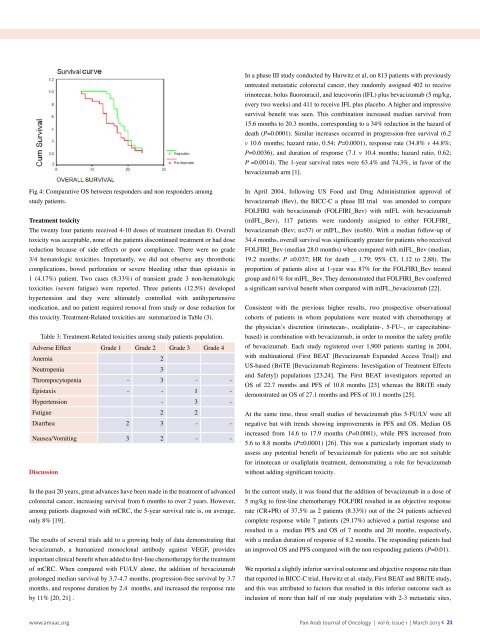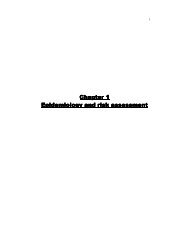Pan Arab Journal of Oncology - Arab Medical Association Against ...
Pan Arab Journal of Oncology - Arab Medical Association Against ...
Pan Arab Journal of Oncology - Arab Medical Association Against ...
You also want an ePaper? Increase the reach of your titles
YUMPU automatically turns print PDFs into web optimized ePapers that Google loves.
In a phase III study conducted by Hurwitz et al, on 813 patients with previouslyuntreated metastatic colorectal cancer, they randomly assigned 402 to receiveirinotecan, bolus fluorouracil, and leucovorin (IFL) plus bevacizumab (5 mg/kg,every two weeks) and 411 to receive IFL plus placebo. A higher and impressivesurvival benefit was seen. This combination increased median survival from15.6 months to 20.3 months, corresponding to a 34% reduction in the hazard <strong>of</strong>death (P=0.0001). Similar increases occurred in progression-free survival (6.2v 10.6 months; hazard ratio, 0.54; P=0.0001), response rate (34.8% v 44.8%;P=0.0036), and duration <strong>of</strong> response (7.1 v 10.4 months; hazard ratio, 0.62;P =0.0014). The 1-year survival rates were 63.4% and 74.3%, in favor <strong>of</strong> thebevacizumab arm [1].Fig 4: Comparative OS between responders and non responders amongstudy patients.Treatment toxicityThe twenty four patients received 4-10 doses <strong>of</strong> treatment (median 8). Overalltoxicity was acceptable, none <strong>of</strong> the patients discontinued treatment or had dosereduction because <strong>of</strong> side effects or poor compliance. There were no grade3/4 hematologic toxicities. Importantly, we did not observe any thromboticcomplications, bowel perforation or severe bleeding other than epistaxis in1 (4.17%) patient. Two cases (8.33%) <strong>of</strong> transient grade 3 non-hematologictoxicities (severe fatigue) were reported. Three patients (12.5%) developedhypertension and they were ultimately controlled with antihypertensivemedication, and no patient required removal from study or dose reduction forthis toxicity. Treatment-Related toxicities are summarized in Table (3).Table 3: Treatment-Related toxicities among study patients population.Adverse Effect Grade 1 Grade 2 Grade 3 Grade 4Anemia 2Neutropenia 3Thrompocytopenia - 3 - -Epistaxis - - 1 -Hypertension - 3 -Fatigue 2 2Diarrhea 2 3 - -Nausea/Vomiting 3 2 - -DiscussionIn April 2004, following US Food and Drug Administration approval <strong>of</strong>bevacizumab (Bev), the BICC-C a phase III trial was amended to compareFOLFIRI with bevacizumab (FOLFIRI_Bev) with mIFL with bevacizumab(mIFL_Bev), 117 patients were randomly assigned to either FOLFIRI_bevacizumab (Bev; n=57) or mIFL_Bev (n=60). With a median follow-up <strong>of</strong>34.4 months, overall survival was significantly greater for patients who receivedFOLFIRI_Bev (median 28.0 months) when compared with mIFL_Bev (median,19.2 months; P =0.037; HR for death _ 1.79; 95% CI, 1.12 to 2.88). Theproportion <strong>of</strong> patients alive at 1-year was 87% for the FOLFIRI_Bev treatedgroup and 61% for mIFL_Bev. They demonstrated that FOLFIRI_Bev conferreda significant survival benefit when compared with mIFL_bevacizumab [22].Consistent with the previous higher results, two prospective observationalcohorts <strong>of</strong> patients in whom populations were treated with chemotherapy atthe physician’s discretion (irinotecan-, oxaliplatin-, 5-FU–, or capecitabinebased)in combination with bevacizumab, in order to monitor the safety pr<strong>of</strong>ile<strong>of</strong> bevacizumab. Each study registered over 1,900 patients starting in 2004,with multinational (First BEAT [Bevacizumab Expanded Access Trial]) andUS-based (BriTE [Bevacizumab Regimens: Investigation <strong>of</strong> Treatment Effectsand Safety]) populations [23,24]. The First BEAT investigators reported anOS <strong>of</strong> 22.7 months and PFS <strong>of</strong> 10.8 months [23] whereas the BRiTE studydemonstrated an OS <strong>of</strong> 27.1 months and PFS <strong>of</strong> 10.1 months [25].At the same time, three small studies <strong>of</strong> bevacizumab plus 5-FU/LV were allnegative but with trends showing improvements in PFS and OS. Median OSincreased from 14.6 to 17.9 months (P=0.0081), while PFS increased from5.6 to 8.8 months (P=0.0001) [26]. This was a particularly important study toassess any potential benefit <strong>of</strong> bevacizumab for patients who are not suitablefor irinotecan or oxaliplatin treatment, demonstrating a role for bevacizumabwithout adding significant toxicity.In the past 20 years, great advances have been made in the treatment <strong>of</strong> advancedcolorectal cancer, increasing survival from 6 months to over 2 years. However,among patients diagnosed with mCRC, the 5-year survival rate is, on average,only 8% [19].The results <strong>of</strong> several trials add to a growing body <strong>of</strong> data demonstrating thatbevacizumab, a humanized monoclonal antibody against VEGF, providesimportant clinical benefit when added to first-line chemotherapy for the treatment<strong>of</strong> mCRC. When compared with FU/LV alone, the addition <strong>of</strong> bevacizumabprolonged median survival by 3.7-4.7 months, progression-free survival by 3.7months, and response duration by 2.4 months, and increased the response rateby 11% [20, 21] .In the current study, it was found that the addition <strong>of</strong> bevacizumab in a dose <strong>of</strong>5 mg/kg to first-line chemotherapy FOLFIRI resulted in an objective responserate (CR+PR) <strong>of</strong> 37.5% as 2 patients (8.33%) out <strong>of</strong> the 24 patients achievedcomplete response while 7 patients (29.17%) achieved a partial response andresulted in a median PFS and OS <strong>of</strong> 7 months and 20 months, respectively,with a median duration <strong>of</strong> response <strong>of</strong> 8.2 months. The responding patients hadan improved OS and PFS compared with the non responding patients (P=0.01).We reported a slightly inferior survival outcome and objective response rate thanthat reported in BICC-C trial, Hurwitz et al. study, First BEAT and BRiTE study,and this was attributed to factors that resulted in this inferior outcome such asinclusion <strong>of</strong> more than half <strong>of</strong> our study population with 2-3 metastatic sites,www.amaac.org <strong>Pan</strong> <strong>Arab</strong> <strong>Journal</strong> <strong>of</strong> <strong>Oncology</strong> | vol 6; issue 1 | March 2013 < 21









